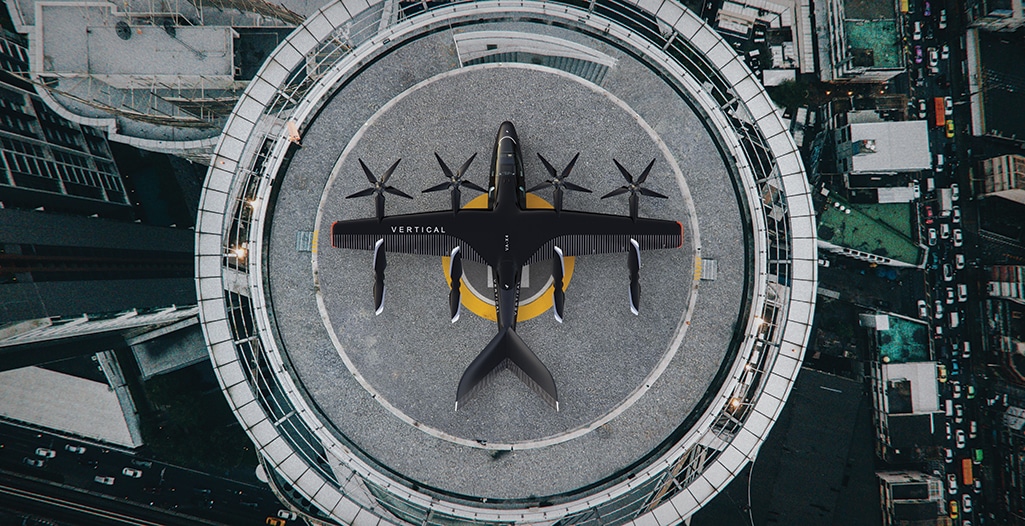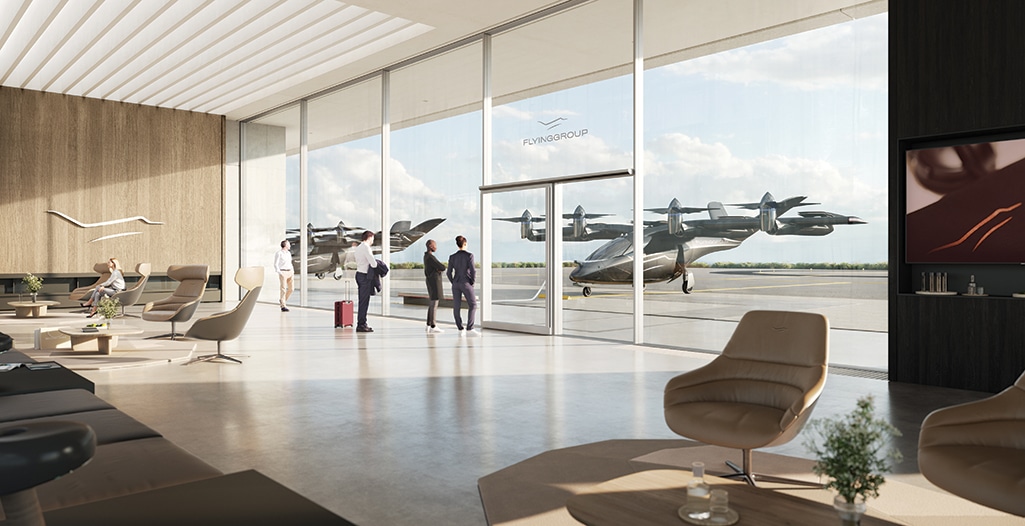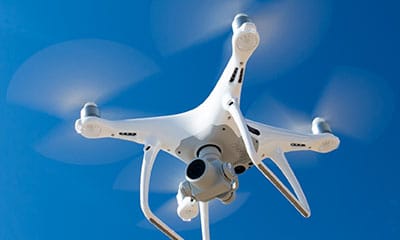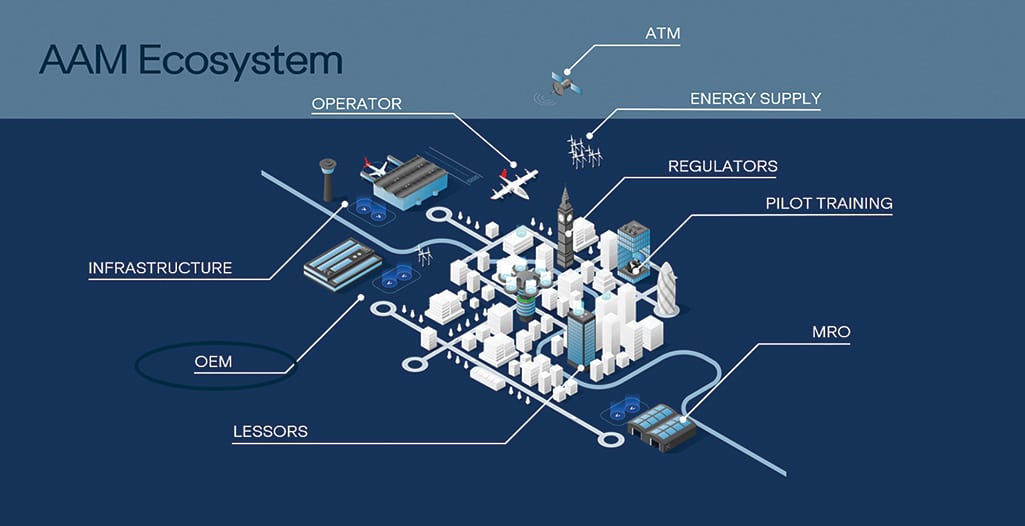Future Flight: The Rise of Advanced Air Mobility
With companies and investors committing billions to the emerging Advanced Air Mobility (AAM) market, there are many opportunities and challenges ahead for the sector.

We spoke to Vertical Aerospace, who are developing the VX4—a 4-passenger, single-pilot, electric vertical take-off and landing (eVTOL) aircraft—to find out their perspective on the journey ahead.
Questions for Vertical Aerospace
With the development of AAM aircraft progressing rapidly and the potential for operations commencing in 2024, what will the infrastructure required to operate these aircraft look like in the early stages?
These new electric aircraft will need an ecosystem to fly commercially—ground infrastructure to land and take off, of course, as well as air traffic control and air traffic services, charging and power supplies, maintenance and aircraft services and regulation and public engagement.
That ecosystem will be built over time from a mix of existing elements and new ones. We aren’t talking about a completely new system opening on day one of AAM flying. It is about how we pragmatically make all the parts work safely and expand capacity and efficiency over time.
We believe we will learn best by doing. That is why Vertical Aerospace, together with Virgin Atlantic and partners including Heathrow, Atkins, Skyports and NATS, are building a first-of-a-kind ecosystem to accelerate introduction of AAM in the U.K. This consortium of partners has been granted £9.5 million of government funding from the “Future Flight Challenge.”
The consortium will be creating and testing technological developments in aircraft electrification, airspace management and ground infrastructure to implement a new model of aerial passenger transport in the U.K.
Does the U.K.’s limited size and congested airspace present a greater opportunity for AAM solutions compared to other locations that already have a large general aviation presence such as the U.S.?
Vertical has over 1,400 aircraft on conditional pre-order across the world. We are seeing real opportunities in all kinds of regions—from Sao Paulo in Brazil, to Malaysia, or western Japan or multiple U.S. states. So, there is no lack of opportunity across lots of geographies and countries.
The flights look similar across many regions—transfers to airports, filling short distance gaps in transport networks and tourism. It is certainly true the U.K. provides ample opportunities to deliver safe, clean, quiet travel. We are delighted to be working with Virgin Atlantic to offer VX4 flights in the U.K. in the future.
For instance, consider Belfast to Glasgow. The 2.5 to 4 hours via domestic airplane flight, cars and ferries could be cut to 47 minutes. A Manchester-to-Liverpool journey that would take 2.5 to 3 hours via train or car could be cut to 50 minutes via VX4. Both save money and, critically, carbon versus existing ground or air transport options as well. Further examples can be found in Vertical’s AAM white paper.1

Do you foresee existing airports being used as AAM hubs with customers using AAM aircraft as the first/last leg of an international journey?
Absolutely. It is one of the three very common types of flight we are seeing with customers around the world. AAM connecting to traditional flights is a great opportunity for airlines to offer safe, fast and comfortable onward journeys.
Much has been spoken about an air taxi use case for AAM. Is there adequate investment in city vertiports
to make this a reality?
It depends on what you mean by “air taxi.” We don’t believe we will see electric aircraft flying people a few blocks around a city in high volumes anytime soon. There are lots of reasons for that, of which the lack of places to land is only one. Airspace, the economics and physics of very short flights, the rate at which aircraft can be produced and competition with other very-short-distance-travel options all make that a challenge or something that will take time to emerge.
What quiet, safe, electric aircraft do allow is lots of very compelling links from cities over distances of 30 to 100 miles, resulting in significant time savings as well as saving money and carbon in most cases. They will require places to land in cities—just not on every block or rooftop. For example, in Sao Paulo, Tokyo or Los Angeles, there are scores of helipads already across the cities. The constraint on using them is about safety and noise—issues that these new aircraft can address. In other cases, we will see new places being created. There are already many firms we are working with such as Ferrovial, Skyports and InfraAmerica looking at developing and investing in these too.
How will passenger security, an integral part of airline travel, be achieved in the AAM ecosystem where you have aircraft using non-airport locations?
Security will always be an integral part of commercial air travel. Travel on AAM aircraft will be of known passengers, in secure cabins with a pilot in an isolated, secure cabin. There are multiple, redundant systems on the aircraft and on the ground ensuring both security and safety. This will make AAM aircraft safer and ensure tighter security measures than are in use with most general small aircraft in the skies today, which are already very secure.
Passenger physical screening in an airport has become commonplace for large commercial aircraft. It is worth recognising that this is not needed or done for smaller aircraft, commercial or otherwise, or at most smaller airfields, with no loss of security. Nor is it done on other public transport in cities, such as rail, subways, buses or taxis. There is no compelling reason or risk-based rationale to do so at AAM vertiports.
Travelling through vertiports in the future will be quicker than large airports, but it doesn’t mean it will be any
less secure. We’re sure vertiports and operators will be putting appropriate measures in place.
Exciting Times Ahead
It is fascinating to hear about the new opportunities that AAM will create for the aviation sector, utilising new aircraft technologies that will improve connectivity whilst advancing the industry’s green credentials. It is clear that the ecosystem surrounding this new breed of aircraft is vital to their success, and we look forward to following the ongoing developments in this space.
References
1 The Future of Advanced Aerial Mobility (PDF)





